Dec 14, 2025
Dec 14, 2025
During my recent visit to India, I had the unique opportunity to attend the yearly celebration of the Spirit Dance (bhuta kola) in Dakshina Kannada in Karnataka State. This dance is a performance by spirit-forms (bhutas) that have attained demigod status in the eyes of villagers. The ancient tradition as practiced for many centuries is very prevalent in coastal Karnataka and Kerala (the region called Parashurama Sristi - the part of sea reclaimed by Lord Parashurama).
The yearly celebrations are held on the premises of the gudi or sthana (abode), where usually an idol of Durga is kept. The gudi is the sanctum sanctorum for the bhutas.
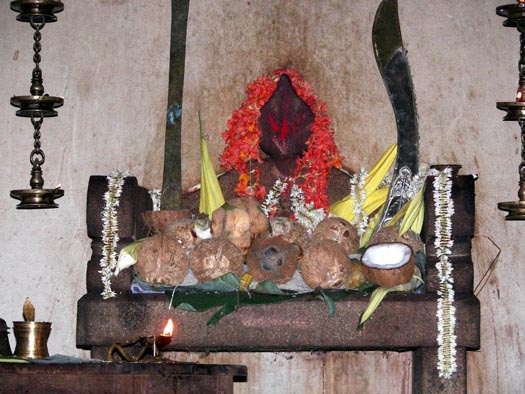
Inside the Sanctum Sanctorum
On the upper story of the gudi is a statue of the main spirit, Hallathayi. It is a life-sized stone idol sculpted in the appearance of a fully adorned Hallathayi. No one knows how old it is. There is barely enough space for the statue to stand in total darkness, and the entrance is a narrow treacherous staircase. I went up to shoot a picture of this imposing statue, but the feeling was eerie. I did not spend much time up there.
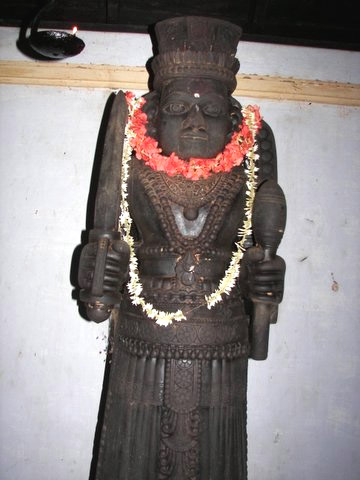
Life-sized statue of Hallathayi
The dance rituals are all-night affairs. There is a local fair that sells trinkets and clothing for the villagers' benefit. (Now progress has reached the villages and a DVD movie is shown on television screen as part of the attractions.) The major landlord of the village, (who also foots the bill for the ceremony), is the guest of honor. One of the members of the family will attend the ceremony and get their assurance from the bhuta that the gods have been satisfied with the villagers' conduct and promises to protect the village for the coming year.
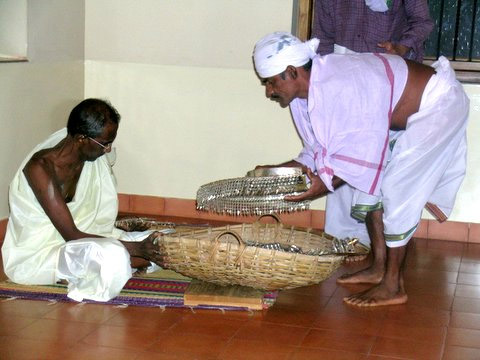
Each ornament is counted and tabulated before being taken by the villagers
It started with the ceremonial transfer of the silver jewelry to be worn by the dancers from the landlord's house, on the night before the festivities. This year the celebration was spread over two nights. On the first night the dance ritual was conducted in a place called Upper Kondla (often pronounced as Kolna) in the village of Neria. The major player or the main bhuta here is called Hallathayi.
The event takes place on February 13p>th of every year. The ritual in the Lower Kondla takes place on the following night with offerings to bhuta Raktheswari, who has her own gudi there. The major landowner of the village has maintained the upkeep of both the gudis. The dances on the second night starts with a fierce bhuta called Kadapu Panjurli, who dances on top of a hill (more about it later). These two last bhutas dance only on alternate years.
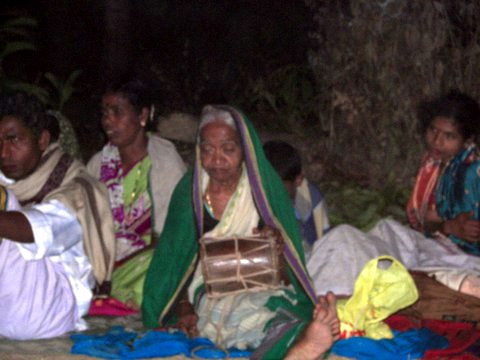
The ladies of the family singing the Pad-dana
The aura and the strength of the bhutas are derived from Durga, the female personification of Hindu pantheon of gods. They usually are fierce forms of Durga, reminiscent of Kali. However, the bhutas are not considered as gods but are sentries of god, especially of Durga. Every spirit has a story and history behind it. While the long process of makeup of the dancer is in progress, the women, to the beat of a simple drum, sing the story of the bhuta's previous travels and the heroics of the spirit's prior adventures. These songs are called Pad-dana (many of the folk songs in Tulu Nadu are sung in the style of Pad-dana). The dance ritual can only be performed by a certain caste of Hindus. A single-family usually inherits the right to dance, performed by male members of the family. The women folks of this family know the Pad-dana that is relevant to the particular spirit.
Hallathayi of Upper Kondla
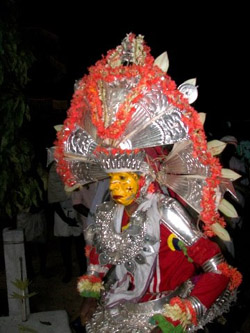
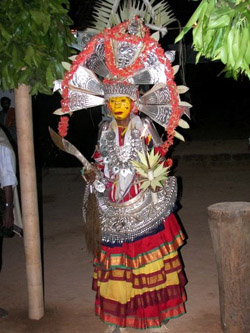
A fully adorned Hallathayi Hallathayi makes her Dramatic Appearance
The most respected bhuta here is Hallathayi, a female who has attained powers of Durga. She has a horse as her vehicle (vahana). Pili-Chamundi, another form of Durga with tiger as her vehicle dances next. A wooden horse is used by for Hallathayee to circumambulate the gudi three times during the dance ritual.
Bejeweled with silver ornaments, colorful skirt and a long plait, Hallathayi carries herself well despite the weight of the silver jewelry. She is adorned with a large headdress as well as ear and shoulder coverings, a waist piece, bangles and anklets. The anklets are special and essential for the bhutas. These anklets are called gaggara, two hollow metal tubes attached together to form an elliptical shaped ring, with loose metal inside. This provides for a deep metallic sound when shaken. Once the dancer wears the gaggara on his ankles, the spirit he emulates possesses him. For several years now the bhutas have gaggara made of pure silver, thanks to the generosity of the landlord.
A Brahmin priest oversees the proceedings and represents the people on their behalf. His job also is to assuage the bhuta when the spirit roars with anger or is overcome with emotions. He is there to assure the bhutas that they will be well provided for and respected by the villagers. The villagers offer many items like coconuts, fowl and goats to the bhuta in return for protection for the year. During the dance, the bhuta is provided with coconut water and jaggery water (or toddy) to drink. She demands coconut water with thumping chest, with hands extended.
After her initial dramatic entrance, to a crescendo of beating drums and high pitched horns, (and appeased with enough coconut water and jaggery water or toddy), Hallathayi settles down a bit to finish the order of business. There are a few rituals that have to be performed as part of the dance. While swaying back and forth on her restless ankles with the hollow gong of the gaggara, Hallathayi goes on a lengthy dissertation that also gives us glimpses of her history. The oration of her muffled sentences is in old colloquial Tulu language. I strained my ears to hear the incomprehensible sentences, only to understand a few words. But the ritual is incomplete without the customary jargon uttered by the bhuta. Then she goes into another tirade and a fiery torch made from palm leaves is given to her and she illuminates her face with it. When exhausted she fans herself with a handheld fan called chamara (that looks like a horse's tail). Now she is gratified, and meets the landlord and assures him of protection and continued surveillance of his property.
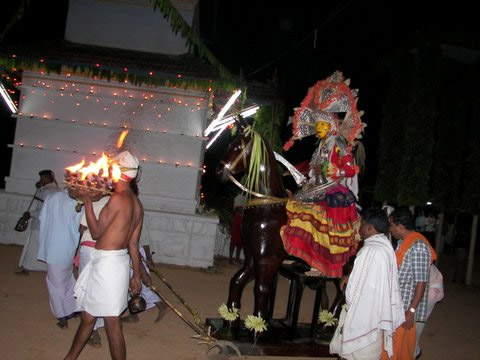
Hallathayi on her horse
Then it is time for Hallathayi to mount her horse. The mechanical horse made for this purpose is pulled by some of the villagers, circumambulating the gudi three times. She finishes her performance by blessing the villagers, who have come forward to give her offerings. Each one is given a frond of flower of areca nut (called pingara), and touched with her sword, while chanting a blessing.
Pili-Chamundi of Upper Kondla
Following Hallathayi comes Chamundi (another Durga manifestation) with a much lighter garb. Her dance is more energetic and vigorous, in step with the beat of drums and horns. She has a mask resembling the face of a tiger (that reminds one of Kali with her tongue extended)
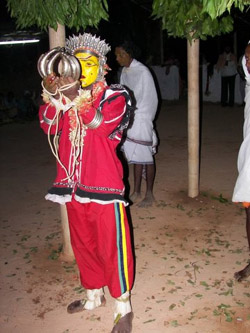
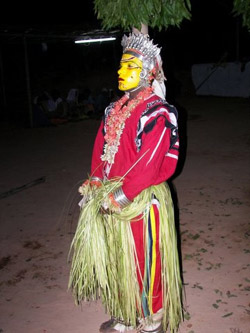
Accepting the gaggara for the dance Pili-Chamundi in praying with his grass skirt
After she accepts the gaggara in front of the gudi, she wears the skirt made from the fronds of coconut palm. The dress is complete when she wears another larger skirt and a back shield made from the same material. She runs from group to group demanding coconut water and other gifts. She is also given the torch, chamara and the mask of a tiger that she holds in front of her face while she lets out a fierce roar that reverberates in the jungle around.
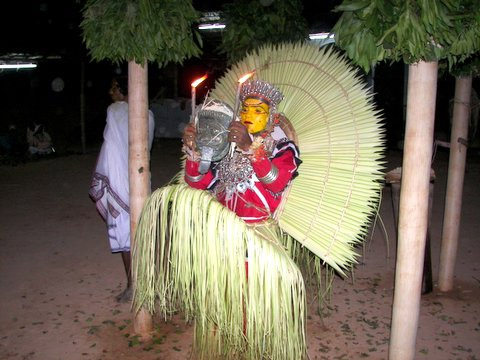
Fully dressed with grass skirt, shield and the tiger mask
The torch gives the possessed dancer a sense of power
Following the dance ritual, the bhuta visits with the villagers and blesses them with her sword. People tell her their problems, and she assures them that all their difficulties will be solved with the help of their faith. The festivities ended in the wee hours of the morning.
Kadapu Panjurli of the Hilltop
Early next night, I went to see the formidable bhuta that has taken the form of a wild boar. This spirit called Kadapu Panjurli dances in front of a gudi on a hill. This is also a female bhuta and the origin of the bhuta is interesting. Long time ago, it was common for the villagers to be threatened by herds of elephants. The elephants caused much destruction of life and crop. The villagers used to dig wide pits and ditches (known as kadapu) around the village to prevent the elephants from venturing into their lands. This was not always successful, they believed, unless they had the protection and blessings of this bhuta - Panjurli with the face of a wild boar.
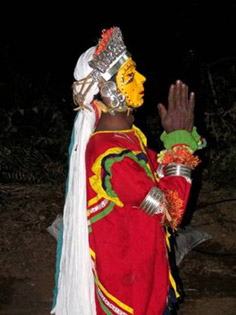
Kadapu Panjurli seeking blessings before the performance
The bhuta dance starts with the priest giving the dancer coconut oil in his hand. Kadapu Panjurli is immediately possessed, as soon as the oil touches the dancer's hand. He pounces and rolls on the ground shaking and vibrating, as the loud music hits a crescendo, and eventually passes out after a series of uncontrollable conniptions. When the dancer comes to his senses, he proceeds to adorn his makeup, while the women of his family sing the Pad-dana and recount the bhuta's history. When the makeup is done the bhuta is transformed and dances to vigorous trumpets, horns and drums until she is exhausted. She demands more coconut water, toddy and fowl. When she is presented with a rooster, she kills it and symbolically eats it while trembling as if she is possessed. The scene is gruesome.
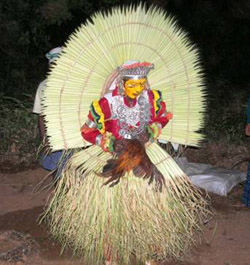
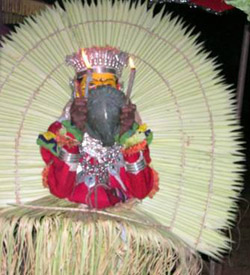
Kadapu Panjurli with the sacrificial fowl and the mask of the boar.
Needless to say, I was a bit shaken after this dance performance. Fortunately, this ritual is performed only once in two years. The bhuta in her trance had to be cooled down by the villagers with fans. She stared down the whimpering villagers who promised to appease her more than they already had with more gifts. Finally, when she settled down, she went around blessing the villagers. I left to catch a few hours of sleep before the next performance in the Lower Kondla later that night.
Raktheswari and Bhavana of Lower Kondla
I returned to Lower Kondla to see the main bhuta Raktheswari dance at about two in the morning.. She is another incarnation of Durga, who is a very popular bhuta in this part of the state. The Pad-dana went on for a long time as this bhuta has quite a history. She is also accompanied by one of her soldiers called Bhavana. He can be characterized as the sidekick of Raktheswari, who provides comic relief during the act. Unlike Hallathayi, Raktheswari's hair is not tied in a braid, but left loose. In most of the villages in Dakshina Kannada, Raktheswari is the most powerful spirit. In Kondla, however, a less powerful incarnation of Raktheswari, namely Hallathayi, has attained a more prestigious state. Legend has it that Hallathayi during her wanderings fell in love with Kondla and decided to settle down there. She was more pleased when the villagers recognized her powers and built the permanent abode for her in Upper Kondla. So Raktheswari was relegated to a lesser role to Lower Kondla with the bhuta kola (dance ritual) only once in two years.
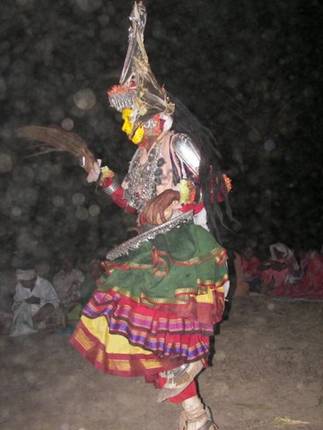
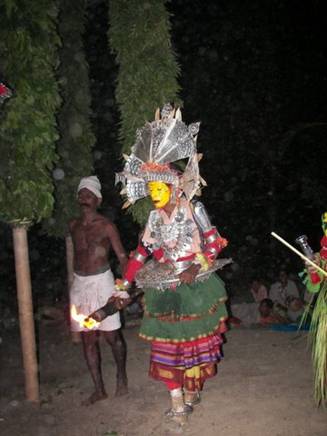
Raktheswari, with her ornaments and open hair makes her entrance
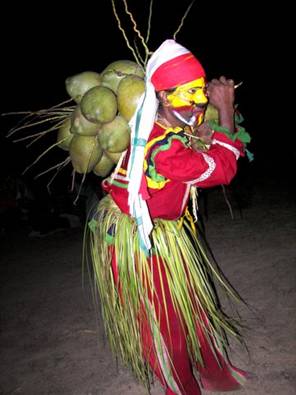 Like Hallathayi, Raktheswari also adorns heavy silver ornaments, which slows down her movements. But the sidekick or Bhavana has no such restrictions. Bhavana actually translates to imagination (kalpana,) and could all be the figment of the imagination of the audience. Nevertheless, Bhavana provides excellent entertainment for the simple folks of the village. He clowns around Raktheswari, stealing the coconuts as she drinks them, and generally acting nettlesome. He not only dances vigorously to loud music, but also talks incessantly about his heroics and histrionics. The villagers enjoy his act and encouraged by his silly dialogue, instigate him further by their comments and laughter. He demands more coconut for all the work he has been doing throughout the year in protecting the gardens from the robbers. At the same time he is seen stealing bunches of coconuts himself, in this act of comedy.
Like Hallathayi, Raktheswari also adorns heavy silver ornaments, which slows down her movements. But the sidekick or Bhavana has no such restrictions. Bhavana actually translates to imagination (kalpana,) and could all be the figment of the imagination of the audience. Nevertheless, Bhavana provides excellent entertainment for the simple folks of the village. He clowns around Raktheswari, stealing the coconuts as she drinks them, and generally acting nettlesome. He not only dances vigorously to loud music, but also talks incessantly about his heroics and histrionics. The villagers enjoy his act and encouraged by his silly dialogue, instigate him further by their comments and laughter. He demands more coconut for all the work he has been doing throughout the year in protecting the gardens from the robbers. At the same time he is seen stealing bunches of coconuts himself, in this act of comedy.
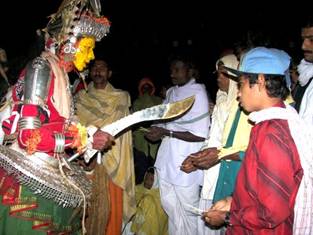 Raktheswari has an enamored origin in the legend. She was the spirit summoned by devas and rishis to defeat the demon Rakta-bija, who had become so strong that he was challenging and hectoring the gods and devas. With his unbound power to clone himself as soon as a drop of his blood touched the ground, Rakta-bija threatened the very foundation decent life and the existence of the gods. It was up to Raktheswari to duel with Rakta-bija and eventually annihilate him and his brood in a fierce battle. Since then she is revered as a spirit who protects the faithful.
Raktheswari has an enamored origin in the legend. She was the spirit summoned by devas and rishis to defeat the demon Rakta-bija, who had become so strong that he was challenging and hectoring the gods and devas. With his unbound power to clone himself as soon as a drop of his blood touched the ground, Rakta-bija threatened the very foundation decent life and the existence of the gods. It was up to Raktheswari to duel with Rakta-bija and eventually annihilate him and his brood in a fierce battle. Since then she is revered as a spirit who protects the faithful.
When the customary sentences are uttered and Raktheswari is satisfied with the coconuts and jaggery water, she promises to care for the villagers and their crop. She assures them that there will not be any diseases or hardships they would have to face. Then she receives the offerings from the villagers and blesses them.
The End
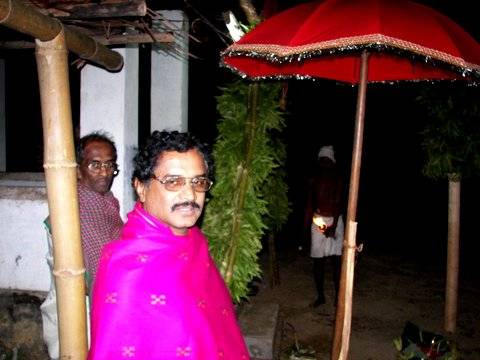 The Brahmin priest plays an important role in the two nights of ceremonies. He is the conductor of the proceedings. He knows the history of each bhuta's travels and their heroics from the past. He answers the questions posed to him in order to appease the bhuta. The idea is not to agitate the spirit.
The Brahmin priest plays an important role in the two nights of ceremonies. He is the conductor of the proceedings. He knows the history of each bhuta's travels and their heroics from the past. He answers the questions posed to him in order to appease the bhuta. The idea is not to agitate the spirit.
The villagers left the scene in the early hours of the morning, happily looking forward to another year of safety and protection by their beloved spirit gods. The bhutas of both Upper and Lower Kondla were satisfied with the people for their faith. People of the village of Neria had done their duty.
I went home for a diurnal slumber feeling quite safe. When I awoke late that morning, I wondered as to how long such an ancient practice can be supported in rapidly changing India. Will the people a hundred years from now still have the same faith they now have in their bhutas? Or will they say that these are blind faiths and ignore and rescind Hallathayi, Raktheswari, Pili-Chamundi and Kadapu Panjurli? Will they just be forgotten words, not even recounted in the Pad-danas?
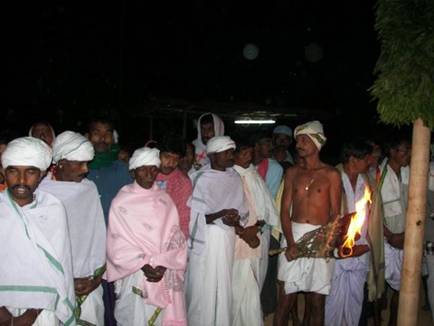
The faithful villagers feel reassured
But then I reassured myself. Other centuries-old practices have become integral parts of Indian culture. India is averse to change, especially when it comes to tradition and faith. The longevity of the bhutas of Kondla may surprise us all.
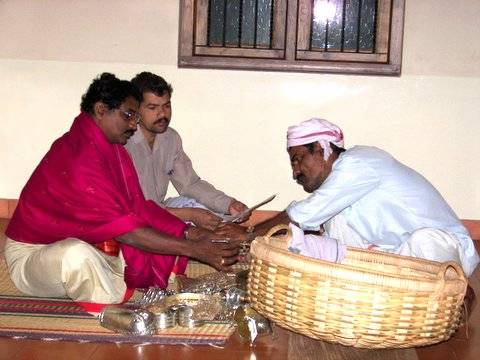
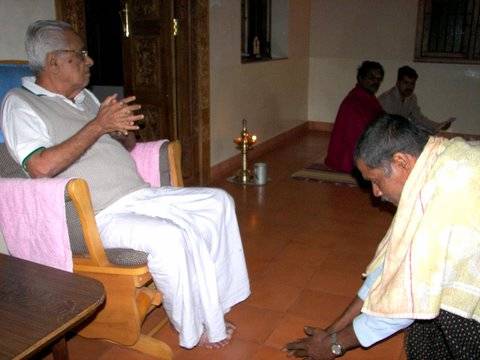
The ornaments are returned for safekeeping
and the landlord is thanked for his patronage of the bhutas of Kondla
The ornaments of the bhutas were returned to the landlord's house for safekeeping for another year. The bhuta dancers were paid an extra amount and the women folks were given saris and other household items. They all left with smiles on their faces, exhausted but already looking forward to next year's festivities.
23-Apr-2006
More by : Dr. Neria H. Hebbar

|
very nice sir |